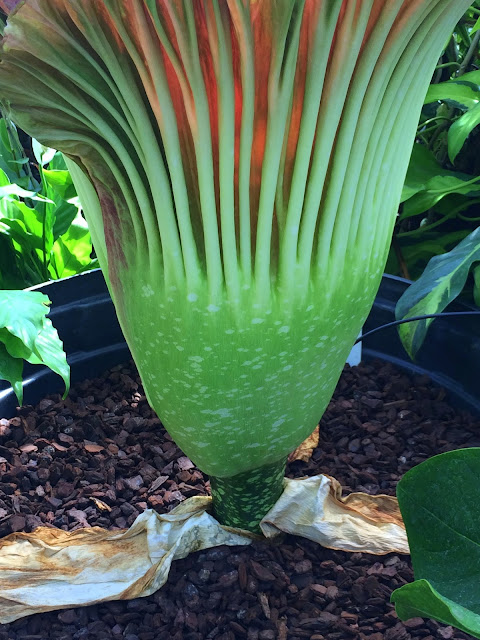Yesterday I
had the opportunity to visit the Foster Botanical Garden in Honolulu, HI. The
Occasion? Being witness to blooming of one of the world’s largest and rarest
flowering structures, the corpse flower also known as titan arum. The corpse
flower blooms for a very short time (12 hours) and when in bloom emits a very
pungent odor like a dead and decaying animal or corpse.
 |
| Corpse flower at Foster Botanical Garden, Honolulu, HI |
 |
| The spathe of the flower |
 |
| Close up of the skirt like structure called Spathe. |
Why the
strong and pungent smell? It all comes to continuation of species. The smell, color and temperature is for attracting
insects for pollination to continue the species. Dung beetles, flesh flies and
other carnivorous insects are the primary pollinators of this type of flower.
 |
| The skirt and the origin of the phallus like structure |
The corpse
flower has designed a very clever way of fooling the insects into believing
that it is a piece of flesh/ dead animal due to the smell, warming itself up to
98 degrees Fahrenheit (36.7 Celsius) and
the burgundy color, attracting the beetles. Eventually as the insect take-off
after sitting on the flower, they have pollens sticking on their legs for
pollinating other flower. Once this
task completed the flower
collapses and shrivel up.
The
scientific name of the corpse flower is Amorphophallus titanium. (from Ancient Greek amorphos,
"without form, misshapen" + phallos, "phallus",
and titan,
"giant"). The legendary Sir David Attenborough first used the name titan arum to
refer to this magnificent tropical plant in the BBC series The Private
Lives of Plants because he felt viewers might be offended by the
plant’s Latin name, Amorphophallus titanum. The corpse flower is not a
single flower but an inflorescence (a stalk of many flowers). It consists of
mixture of tiny male and female flowers clumped together at the base of phallus
like structure called (spadix)
surrounded by a beautiful pleated
skirt-like covering (spathe) that is bright green on the outside and deep maroon/
burgundy inside when opened.
The female
flower precedes the male flowers to maturity, hence self-pollination is not
possible, requiring the help of insects.
 |
| Life cycle of the corpse plant. Courtesy UC Davis |
The
inflorescence which can grow over 3 metres
(10 ft) in height rises from the tuber, which is a
large spherical underground stem modified to store food for the plant. It is
very large and weighs around 100 pounds. After the inflorescence withers-off, a
single leaf sprouts from the tuber reaching a height of 6-7 meter and branching
into numerous leaflets. Every year the leaf withers and new emerges till the
plant is ready to flower again. This cycle continues through 40 years which is the total life span of this plant
If
pollinated, the stalk grows into a large club like head of orange seeds.
 |
| The seeds of corpse plant : Courtesy Funflower Facts.com |
The corpse
flower was first discovered in Sumatra in 1878 by Italian botanist Odoardo
Beccari, according to the UC Botanical Garden. The plant grows in the wild only
in tropical rainforests of Asia. It is an endangered plant because of habitat
destruction in most part of Indonesia, decrease in insect population
that pollinate the plant and help in seed distribution. Indonesia has probably
lost 72% of its native rainforests and the deforestation continues.
 |
| The burgundy Spathe |
The plant is
very difficult to cultivate and only handful of places across the globe have
been successful in doing so! It also requires 7-10 years of vegetative growth
before blooming for the first time. There are about 100 cultivated corpse
plants around the world.
 |
| A man smelling the corpse plant. |
Another
flower with very strong odor is Rafflesia arnoldii, world largest bloom. It is
a parasitic plant, with no visible roots, leaves or stem. It grows to a
diameter of 3 feet, weighing as much as 15 pounds. When in bloom, the Rafflesia
emits a repulsive odor, similar to that of rotting meat. This odor attracts
insects that pollinate the plant.
Plants like
this are magnificent and make us realize the complexity and biodiversity of the
botanical world.
References:
http://discovermagazine.com/2013/oct/15-exquisite-corpse-flowers
http://www.kew.org/science-conservation/plants-fungi/amorphophallus-titanum-titan-arum
Intriguing
ReplyDeleteIntriguing indeed.Lucky to be in the right place at right time.
DeleteNice write up & wonderful pictures.
ReplyDeleteinformative about corpse flower. Amazing flower
Thanks
Thanks,Ritesh Gupta!
DeleteThat blooming flower needs to be placed right in the white house. stench will match the creature in the white house.
ReplyDelete